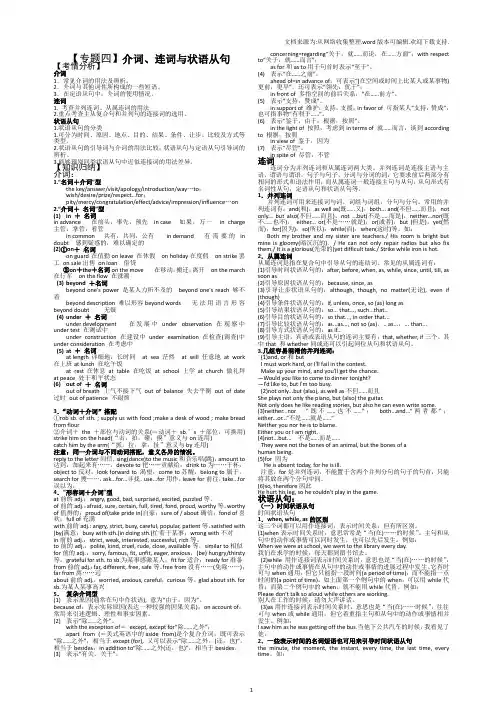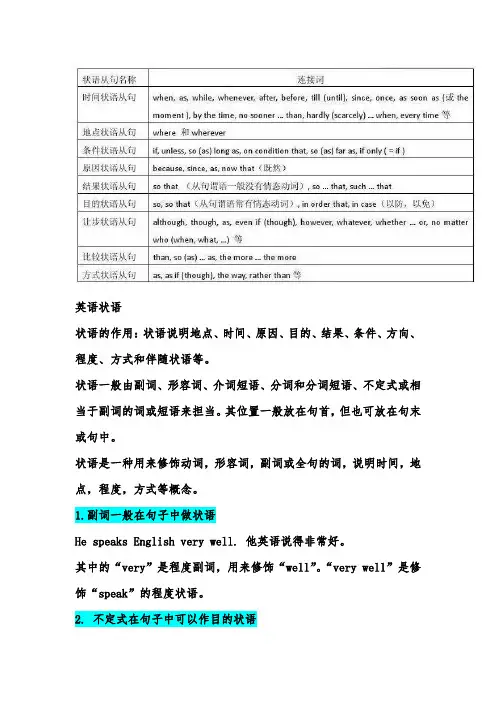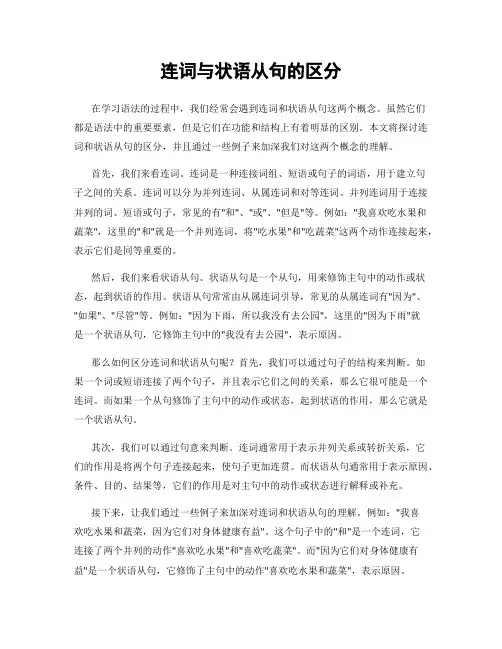连词和状语从句
- 格式:ppt
- 大小:416.00 KB
- 文档页数:28

连词与状语从句知识梳理连词与状语从句知识梳理知识梳理知识点1:一、连词含义连词是一种虚词,不能担任一个句子成分。
它主要是包括并列连词和从属连词。
二、具体用法1. 并列连词1). 并列连词的功能:连词在句中主要起连接词与词、短语与短语及句子和句子的作用。
即,连接两个平行的成分或句子。
如:and, but, or, nor, so, therefore, yet, however, for, as well as, both…and, not only…but also, either…or, neither…nor, (and)then等等。
2). 并列连词的用法:表示连接两个共同概念and 和or1) 并列结构中,or 通常用于否定句,and 用于肯定句。
2) 但有时and 也可用于否定句。
请注意其不同特点:There is no air or water in the moon.There is no air and no water on the moon.在否定中并列结构用or 连接,但含有两个否定词的句子实际被看作是肯定结构,因此要用and 。
both …and 两者都(两者都强调,谓语动词为复数)not only…but (also),不但…而且(强调后者,就近原则)注意:not only… but also关联两个分句时,一个分句因有否定词not 而必须倒装。
Not only does he like reading stories, but also he can even write some.neither …nor 意思为" 既不……也不……" (就近原则)Neither you nor he is to blame.as well as也 (强调前者,就远原则)The students as well as their class teacher like watching football matches very much.I have one of his plays as well as a few of his novels.表示选择的并列结构1) or意思为" 否则" 。

【专题四】介词、连词与状语从句【考情分析】介词1.常见介词的用法及辨析。
2.介词与其他词性所构成的一些短语。
3.在定语从句中,介词的使用情况。
连词1. 考查并列连词、从属连词的用法2.重点考查主从复合句和并列句的连接词的选用。
状语从句1.状语从句的分类1.可分为时间、原因、地点、目的、结果、条件、让步、比较及方式等类型。
2.状语从句的引导词与介词的用法比较;状语从句与定语从句引导词的辨析。
3.能够辨别同类状语从句中近似连接词的用法差异。
【知识归纳】介词:1.“名词+介词”型the key/answer/visit/apology/introduction/way…to;wish/desire/prize/respect…for;pity/mercy/congratulation/effect/advice/impression/influence…on 2.“介词+名词”型(1) in +名词in advance 在前头,事先,预先in case 如果,万一in charge 主管,掌管,看管in common 共有,共同,公有in demand 有需要的in doubt 感到疑惑的,难以确定的(2)①on+名词on guard 在值勤on leave 在休假on holiday在度假on strike罢工on sale出售on loan 借贷②on+the+名词on the move 在移动,搬迁;离开on the march 在行军on the flow 在涨潮(3) beyond +名词beyond one's power 是某人力所不及的beyond one's reach 够不着beyond description 难以形容beyond words 无法用语言形容beyond doubt 无疑(4) under +名词under development 在发展中under observation 在观察中under test 在测试中under construction 在建设中under examination 在检查(调查)中under consideration 在考虑中(5) at +名词at length 详细地,长时间at sea 茫然at will 任意地at work 在上班at lunch 在吃午饭at rest在休息at table 在吃饭at school 上学at church 做礼拜at peace 处于和平状态(6) out of +名词out of breath 上气不接下气out of balance 失去平衡out of date 过时out of patience 不耐烦3.“动词+介词”搭配①rob sb. of sth. ; supply us with food ;make a desk of wood ; make bread from flour②介词+the +部位与动词的关系(=动词+sb.’s +部位,可换用) strike him on the head(“击,拍,碰,摸”意义与on连用)catch him by the arm(“抓,拉,拿,扯”意义与by连用)注意:同一介词与不同动词搭配,意义各异的情况。


状语从句分类及常用连词一、状语从句分类及常用连词:类别连词地点状语从句where,wherever时间状语从句when, whenever, while, as, before, after, since, till, once, assoon as,etc.原因状语从句because, since, as, for, now that, etc.目的状语从句in order that, so that, that, etc.结果状语从句so…that, so that, such…that, that, etc.条件状语从句if, unless, as(so)long as, etc.让步状语从句though, although, even if, even though, however, whatever, as,etc.比较状语从句as…as, so…as, than, etc.方式状语从句as, as if, as though, etc.二、各种状语从句的连词的用法区别1 地点状语从句地点状语从句通常由where, wherever 引导。
Where I live there are plenty of trees. 我住的地方树很多。
Wherever I am I will be thinking of you. 不管我在哪里我都会想到你。
2 方式状语从句方式状语从句通常由as, (just) as…so…, as if, as though引导。
1)as, (just) as…so…引导的方式状语从句通常位于主句后,但在(just)as…so…结构中位于句首,这时as从句带有比喻的含义,意思是"正如…","就像",多用于正式文体,例如:Always do to the others as you would be done by.你希望人家怎样待你,你就要怎样待人。

英语状语状语的作用:状语说明地点、时间、原因、目的、结果、条件、方向、程度、方式和伴随状语等。
状语一般由副词、形容词、介词短语、分词和分词短语、不定式或相当于副词的词或短语来担当。
其位置一般放在句首,但也可放在句末或句中。
状语是一种用来修饰动词,形容词,副词或全句的词,说明时间,地点,程度,方式等概念。
1.副词一般在句子中做状语He speaks English very well. 他英语说得非常好。
其中的“very”是程度副词,用来修饰“well”。
“very well”是修饰“speak”的程度状语。
2. 不定式在句子中可以作目的状语I come specially to see you. 我专门来看你。
3.介词短语She usually gets up at seven in the morning.她一般在早上七点起床。
“in the morning”是介词短语,在句中作时间状语。
The boy was praised for his bravery.这个男孩因为他的勇敢而被夸奖。
“for his bravery”是介词短语,在句中作原因状语,解释男孩被夸奖的原因。
4.从句作状语When she was 12 years old, she began to live in Dalian.她12岁的那一年开始居住于大连。
此处When引导时间状语,从句在主句中充当时间状语从句。
If I am not busy tomorrow, I will play football with you. 如果我明天不忙,我就会陪你踢足球。
此处If引导条件状语,从句在主句中充当条件状语从句。
5.过去分词作状语Faced with the situation, what are we supposed to do?6.形容词作状语(教材p.62)Early in the' morning,I woke up excited.早晨很早的时候,我醒了,很兴奋。

连词和状语从句高考研究英语中的连词用法比较复杂。
同一个连词可以表达不同的意思,同一个意思可以用不同的连词进行表达,同一个意思可以用不同的连词进行表达,因此在学习连词时应注意以下几点:熟练掌握每一个连词的不同意义和用法;掌握同一意义可以运用不同的连词;同一意义可以运用不同的句式表达等等。
高考中对于连词的考查主要表现在对于并列连词和从属连词的用法和辨析上进行考查。
这是考试的重点和难点所在。
状语从句一般可分为时间状语从句、地点状语从句、原因状语从句、目的状语从句、结果状语从句、条件状语从句、让步状语从句、比较状语从句、方式状语从句。
预测今后高考主要考查在具体的语境中连词的正确使用。
诊断测试1.(2010课标全国,25)Mary made coffee her guests were finishing their meal.A. so thatB. althoughC. whileD. as if2. (2010课标全国,30)The little boy won’t go to sleep his mother tells him a story.A. orB. unlessC. butD. whether3. (2010山东,28)The school rules state that no child shall be allowed out of the school during the day, accompanied by an adult.A. onceB. whenC. ifD. unless4. (2010上海,34) you may have, you should gather your courage to face the challenge.A. However a serious problemB. What a serious problemC. However serious a problemD. What serious a problem5. (2010上海,39) our manager objects to Tom’s joining the club, we shall accept him as a member.A. UntilB. UnlessC. IfD. After6. (2010北京,30) they decide which college to go to, students should research the admission procedures.A. AsB. WhileC. UntilD. Once7. (2010陕西,20)John thinks it won’t be long he is ready for his new job.A. whenB. afterC. beforeD. since8. (2010江西,22)——Our holiday cost a lot of money.——Did it ? Well, that doesn’t matter you enjoyed yourselves.A.as long asB. unlessC. as soon asD. though9. (2010福建,26)The girl had hardly rung the bell the door was opened suddenly, and her friend rushed out to greet her.A. beforeB. untilC. asD. since10. (2010安徽,29)The engineers are so busy that they have zero time for outdoor sports activities, they have the interest.A. whereverB. wheneverC. even ifD. as if知识精讲英语中的连词(Conjunction)是一种虚词,它不能独立担任句子成分,只起连接词与词、短语与短语以及句子与句子的作用。

英语三大从句:名词从句(主语从句、宾语从句、表语从句和同位语从句)、定语从句、状语从句一、引导名词从句的连词从属连词that(可用于所有名词从句,一般可省略)、是否whether,if;疑问连词what, which, who/whom/whose;疑问副词when, where, why, how ——带特殊疑问句,陈述句语序(主+谓)、带不定式复合关系代词whatever, whoever, whomever, whichever, whenever, wherever, however——无论……二、定语从句引导词关系代词:人who (whom whose[后带名词]);事物which(必须的两种情况:有逗号,有介词)、that、as (such… as…,the same as…, 或者如…:与know, see, report, expect, hear,think, hope, wish, like, want, need 等词连用,一般在句首或者做插入语);关系副词when, where, why ——相当于介词+ which关系形容词whose[后带名词]三、带状语从句的连接词:because[biˈkɔz; (uS) biˈkɔːz] conj. 因为as[əz, æz] ad.& conj.像……一样;如同;因为prep. 作为,当做since [sins]ad. 从那时以来conj. 从…以来,…以后,由于prep. 从…以来for [fə(r), fɔː(r)] prep. 为了…;向…,往…;与…交换;防备…;适合…;因为…;在…期间;对于…;对…来说conj. 因为,由于so [səʊ]ad. 如此,这么;非常;同样conj. 因此,所以so that 以便;所以so…that…such… that…now that 既然;由于in order thatConsidering考虑到(一般在句首)Given 考虑到,鉴于(一般在句首)after[ˈɑːftə(r)]r ad. 在后;后来prep. 在…之后;在后面conj. 在…以后before[biˈfɔː(r)] prep. 在…以前;在…前面ad. 以前conj. 在…之前till [til] conj.& prep.直到,直到…为止until [ʌnˈtil] prep.& conj.直到…为止once [wʌns]n& ad. 一次,一度,从前conj. 一旦while [wail; (uS) hwail] conj.在…的时候,和…同时n 一会儿,一段时间when [wen] conj. 当…的时候ad. 什么时候,何时but [bət, bʌt] conj. 但是,可是prep. 除了, 除……外whatever [wɔtˈevə(r)] conj. & pron无论什么,不管什么however [haʊˈevə(r)] ad. 可是conj. 然而,可是,尽管如此whenever [wenˈevə(r)] conj. 每当,无论何时wherever [weərˈevə(r)] conj. 无论在哪里although[ɔːlˈðəʊ] conj. 虽然,尽管though[ðəʊ] conj. 虽然,可是even though 虽然,即使unless [ʌnˈles] conj. 如果不,除非or [ə(r), ɔː(r)] conj. 或;就是;否则that[ðæt] a.& pron那,那个conj. 那,那个(引导宾语从句等)ad. 那么,那样whether [ˈweðə(r); (uS) ˈhweðər] conj. 是否if [if] conj.如果,假使,是否,是不是provided that 如果;条件是(一般在句首)assuming that 假定…(一般在句首)or [ə(r), ɔː(r)] conj. 或;就是;否则either [ˈaiðə(r)] a. 两方任一方的;二者之一conj. 二者之一;要么……nor[nɔː(r)] conj. 也不neither conj. 也不;既不and[ænd] conj. 和;又;而[ənd,]than[ðen, ðæn] conj. 比even if 即使;虽然as if 犹如,好似as long as 只要;和…一样长so long as 只要英文连接词像胶水一样将相关联的句子连接起来,所以又被称为“胶水词”,胶水词就像英语的骨架一样重要,学会了胶水词,同时拥有词组的累积,你就可以轻松灵活的造出任何需要的长句,让你的英文交流如鱼得水。

状语从句在英语语法中扮演着重要的角色。
它们可以用来修饰动词、形容词和副词,从而增强句子的表达力和准确性。
同时,连词在连接状语从句与主句之间起到了关键作用。
本文将探讨英语中的状语从句以及常用的连词。
首先,让我们来了解一下什么是状语从句。
状语从句是一个从句,它在句子中作为副词一样的角色,修饰句子的动词、形容词或副词。
状语从句可以用来表示时间、原因、条件、目的、结果等。
状语从句的引导词有很多种,最常见的包括:when(当),while(当...时),after(之后),before(之前),since(自从),as(当...时候),because(因为),although(尽管),if(如果),unless(除非),as if (好像),so(因此),so that(以便),in order that(为了),although(虽然)等等。
这些引导词可以帮助我们把状语从句与主句连接起来,并使句子更加清晰明了。
接下来,我们来看看一些例子,以更好地理解状语从句和连词的使用。
首先是时间状语从句:“I watched a movie when I got home.”(我回到家后看了一部电影。
)这里,“when”引导的状语从句修饰主句中的动词“watched”,表达了事件发生的时间。
接着是原因状语从句:“He failed the exam because he didn't study.”(他没通过考试是因为他没学习。
)这里,“because”引导的状语从句修饰主句中的动词“failed”,表达了失败的原因。
再来是条件状语从句:“If it rains, we will stay indoors.”(如果下雨,我们会呆在室内。
)这里,“if”引导的状语从句修饰主句中的动词“will stay”,表达了条件。
还有目的状语从句:“I bought a new laptop so that I can work more efficiently.”(我买了一台新笔记本电脑,以便我可以更高效地工作。

连词和状语从句考情分析:从近五年考查情况来看,连词是每年的必考点,其中并列连词的基本用法是重要考点,对从属连词的考查一般结合状语从句来考查,状语从句的时态(主将从现)也是一个常考点。
2017年备考时应掌握好并列连词的基本用法,对从属连词的基本用法和状语从句的时态(主将从现)也应注意。
考点突破考点一: 并列连词的基本用法并列连词按作用可分为表示联合、转折、选择和因果等四大类。
1.表联合关系的并列连词常见的有:(1)and意为“和,又,而,并且”。
如:I like English and math.我喜欢英语和数学。
(2)not only...but also(but as well) 意为“不但……而且……”。
如:Not only my father but also my mother likes watching TV very much.不但我的爸爸,而且我的妈妈也非常喜欢看电视。
(3)as well as 意为“也”。
如:He needs a knife as well as a piece of paper.他需要一把小刀,也需要一张纸。
(4)either...or... 意为“或……或……;不是……就是……”。
either...or... 连接两个主语时,谓语动词的单复数和其邻近的词保持一致,即由or后面的词而定。
如:Either he or I am going to have a meeting.要么他,要么我将参加会议。
(5)neither...nor... 意为“既不……也不……”。
当此词组连接两个主语时,谓语动词的用法和either...or...的用法一样,由nor后面的词而定。
如:Neither the teacher nor the students are happy.老师和学生都不开心。
(6)both...and... 意为“既……又……”。
连接两个主语时,谓语动词用复数形式。

连词与状语从句的区分在学习语法的过程中,我们经常会遇到连词和状语从句这两个概念。
虽然它们都是语法中的重要要素,但是它们在功能和结构上有着明显的区别。
本文将探讨连词和状语从句的区分,并且通过一些例子来加深我们对这两个概念的理解。
首先,我们来看连词。
连词是一种连接词组、短语或句子的词语,用于建立句子之间的关系。
连词可以分为并列连词、从属连词和对等连词。
并列连词用于连接并列的词、短语或句子,常见的有"和"、"或"、"但是"等。
例如:"我喜欢吃水果和蔬菜",这里的"和"就是一个并列连词,将"吃水果"和"吃蔬菜"这两个动作连接起来,表示它们是同等重要的。
然后,我们来看状语从句。
状语从句是一个从句,用来修饰主句中的动作或状态,起到状语的作用。
状语从句常常由从属连词引导,常见的从属连词有"因为"、"如果"、"尽管"等。
例如:"因为下雨,所以我没有去公园",这里的"因为下雨"就是一个状语从句,它修饰主句中的"我没有去公园",表示原因。
那么如何区分连词和状语从句呢?首先,我们可以通过句子的结构来判断。
如果一个词或短语连接了两个句子,并且表示它们之间的关系,那么它很可能是一个连词。
而如果一个从句修饰了主句中的动作或状态,起到状语的作用,那么它就是一个状语从句。
其次,我们可以通过句意来判断。
连词通常用于表示并列关系或转折关系,它们的作用是将两个句子连接起来,使句子更加连贯。
而状语从句通常用于表示原因、条件、目的、结果等,它们的作用是对主句中的动作或状态进行解释或补充。
接下来,让我们通过一些例子来加深对连词和状语从句的理解。
例如:"我喜欢吃水果和蔬菜,因为它们对身体健康有益"。

连词和状语从句(解析版)【重点知识梳理】一、时间状语从句(一)when,while与as引导的时间状语从句1.when,while与as引导时间状语从句的区别they jumped with joy.听到“神舟”九号成功发射的消息,他们高兴地跳了起来。
While I was reading,he came in.我正在看书时,他进来了。
The students sang as they walked.学生们边走边唱。
2.while还可以作并列连词,表示对比,意为“而,却”。
Liu Wang is from Shanxi while Liu Yang comes from Henan.刘旺来自山西,而刘洋来自河南。
3.when也可以作并列连词,意为“这时,那时”。
We were having a meeting when someone broke in.我们正在开会这时突然有人闯了进来。
(二)before与since引导的时间状语从句1.before与since的常用句式It wasn't two years before he left the country.不到两年他就离开了这个国家。
2.since引导的从句如果用非延续性动词,所表示的动作自从句谓语动作算起;若用延续性动词,所表示的动作自动作或状态的完成或结束时算起。
It's two years since we arrived here.我们到这儿两年了。
It's three years since we lived here.我们不住在这里有三年了。
(三)表示“一……就……”含义的词(短语)引导的时间状语从句1.引导时间状语从句,且表示“一……就……”含义的词或短语有:as soon as,the moment,the minute,immediately,directly,hardly/scarcely... when,no sooner... than...。
从属连词及状语从句状语从句概念:用一个句子(从句)来作另一个句子(主句)的状语,用作状语的句子就叫作状语从句。
作什么样的状语就叫什么类型的状语从句。
引导状语从句的连接词是从属连词,状语从句可以在句首,也可以在句尾。
中考主要考查状语从句的类型有:时间状语从句、地点状语从句、原因状语从句、结果状语从句、目的状语从句、条件状语从句及比较状语从句等。
1. 时间状语从句时间状语从句在主句中表示时间,常用连接词有:when(当…时),while(当…时),as(当…时),before(在…之前),after(在…之后),since(自从),not…until(直到……才),as soon as(一…就),once(一旦…就)等。
I didn’t go to bed until I finished my homework. 我直到做完作业才去睡觉。
I can listen to the radio while I work. 我可以边听收音机边工作。
(1) 时间状语从句中,一般要用一般现在时代替一般将来时,一般过去时代替过去将来时。
I will telephone you when he comes. 他来时,我会给你打电话。
(2) when引导时间状语从句,表示主句的动作和从句的动作同时或先后发生,从句的谓语可以是延续性动词,也可以是瞬间动词。
He was working when I went in. 我进去时他正在工作。
When she heard the news, she began to cry. 她听到这个消息,她哭了起来。
(3) while引导的状语从句中常用延续性动词或表示状态的动词,意为“在…期间”。
while还表示两者间的对比关系。
They rushed in while we were singing. 我们唱歌时,他们冲进来。
I like playing football, while Tom likes listening to music.我喜欢踢足球,而汤姆喜欢听音乐。